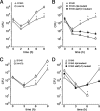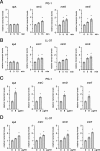The Neisseria meningitidis capsule is important for intracellular survival in human cells
- PMID: 17470547
- PMCID: PMC1932921
- DOI: 10.1128/IAI.01945-06
The Neisseria meningitidis capsule is important for intracellular survival in human cells
Abstract
While much data exist in the literature about how Neisseria meningitidis adheres to and invades human cells, its behavior inside the host cell is largely unknown. One of the essential meningococcal attributes for pathogenesis is the polysaccharide capsule, which has been shown to be important for bacterial survival in extracellular fluids. To investigate the role of the meningococcal capsule in intracellular survival, we used B1940, a serogroup B strain, and its isogenic derivatives, which lack either the capsule or both the capsule and the lipooligosaccharide outer core, to infect human phagocytic and nonphagocytic cells and monitor invasion and intracellular growth. Our data indicate that the capsule, which negatively affects bacterial adhesion and, consequently, entry, is, in contrast, fundamental for the intracellular survival of this microorganism. The results of in vitro assays suggest that an increased resistance to cationic antimicrobial peptides (CAMPs), important components of the host innate defense system against microbial infections, is a possible mechanism by which the capsule protects the meningococci in the intracellular environment. Indeed, unencapsulated bacteria were more susceptible than encapsulated bacteria to defensins, cathelicidins, protegrins, and polymyxin B, which has long been used as a model compound to define the mechanism of action of CAMPs. We also demonstrate that both the capsular genes (siaD and lipA) and those encoding an efflux pump involved in resistance to CAMPs (mtrCDE) were up-regulated during the intracellular phase of the infectious cycle.
Figures






Similar articles
-
Regulation of capsule in Neisseria meningitidis.Crit Rev Microbiol. 2016 Sep;42(5):759-72. doi: 10.3109/1040841X.2015.1022507. Epub 2015 Jun 19. Crit Rev Microbiol. 2016. PMID: 26089023 Free PMC article. Review.
-
Dictyostelium discoideum as a model host for meningococcal pathogenesis.Med Sci Monit. 2008 Jul;14(7):BR134-40. Med Sci Monit. 2008. PMID: 18591912
-
Carbohydrate composition of meningococcal lipopolysaccharide modulates the interaction of Neisseria meningitidis with human dendritic cells.Cell Microbiol. 2005 Sep;7(9):1319-34. doi: 10.1111/j.1462-5822.2005.00559.x. Cell Microbiol. 2005. PMID: 16098219
-
Endotoxin, capsule, and bacterial attachment contribute to Neisseria meningitidis resistance to the human antimicrobial peptide LL-37.J Bacteriol. 2009 Jun;191(12):3861-8. doi: 10.1128/JB.01313-08. Epub 2009 Apr 17. J Bacteriol. 2009. PMID: 19376861 Free PMC article.
-
Genetic organization and regulation of antimicrobial efflux systems possessed by Neisseria gonorrhoeae and Neisseria meningitidis.J Mol Microbiol Biotechnol. 2001 Apr;3(2):219-24. J Mol Microbiol Biotechnol. 2001. PMID: 11321577 Review.
Cited by
-
Gauging the epidemic potential of a widely circulating non-invasive meningococcal strain in Africa.Microb Genom. 2019 Aug;5(8):e000290. doi: 10.1099/mgen.0.000290. Microb Genom. 2019. PMID: 31454306 Free PMC article.
-
Meningococcal pneumonia: a review.Pneumonia (Nathan). 2019 Aug 25;11:3. doi: 10.1186/s41479-019-0062-0. eCollection 2019. Pneumonia (Nathan). 2019. PMID: 31463180 Free PMC article. Review.
-
The sweet side of the pathogenic Neisseria: the role of glycan interactions in colonisation and disease.Pathog Dis. 2017 Jul 31;75(5):ftx063. doi: 10.1093/femspd/ftx063. Pathog Dis. 2017. PMID: 28633281 Free PMC article. Review.
-
Regulation of capsule in Neisseria meningitidis.Crit Rev Microbiol. 2016 Sep;42(5):759-72. doi: 10.3109/1040841X.2015.1022507. Epub 2015 Jun 19. Crit Rev Microbiol. 2016. PMID: 26089023 Free PMC article. Review.
-
Phage-Derived Depolymerase as an Antibiotic Adjuvant Against Multidrug-Resistant Acinetobacter baumannii.Front Microbiol. 2022 Mar 25;13:845500. doi: 10.3389/fmicb.2022.845500. eCollection 2022. Front Microbiol. 2022. PMID: 35401491 Free PMC article.
References
-
- Bucci, C., A. Lavitola, P. Salvatore, L. Del Giudice, D. Massardo, C. Bruni, and P. Alifano. 1999. Hypermutation in pathogenic bacteria: frequent phase variation in meningococci is a phenotypic trait of a specialized mutator biotype. Mol. Cell 3:435-445. - PubMed
-
- Deghmane, A., D. Giorgini, M. Larribe, J. Alonso, and M. Taha. 2002. Down-regulation of pili and capsule of Neisseria meningitidis upon contact with epithelial cells is mediated by CrgA regulatory protein. Mol. Microbiol. 43:1555-1564. - PubMed
Publication types
MeSH terms
Substances
LinkOut - more resources
Full Text Sources
Other Literature Sources

